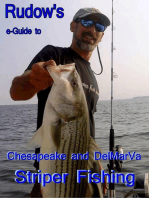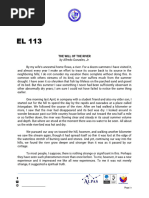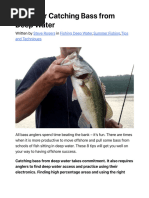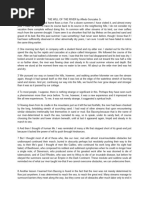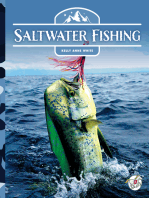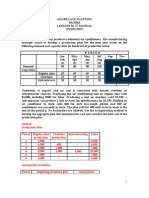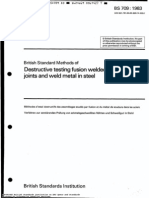He Viscous Flow
He Viscous Flow
Uploaded by
eyob233Copyright:
Available Formats
He Viscous Flow
He Viscous Flow
Uploaded by
eyob233Original Description:
Copyright
Available Formats
Share this document
Did you find this document useful?
Is this content inappropriate?
Copyright:
Available Formats
He Viscous Flow
He Viscous Flow
Uploaded by
eyob233Copyright:
Available Formats
he Viscous Flow Dictionary definitions Viscous flow A type of fluid flow in which there is a continuous steady motion of the
e particles, the motion at a fixed point always remaining constant. Laminar or Laminary consisting of or like thin plates or layers; of or relating to a fluid, streamlined flow Laminar Flow Viscous flow; a fluid flow in which the particles move smoothly without turbulence, esp, as in aircraft, such a non impeding flow over a streamlined surface.
I personally consider this is one of the most important things to realise in all of salmon angling, perhaps the most important thing as far as concentrating fishing effort to taking lies or taking areas is concerned. Understanding this will allow the salmon angler to concentrate his presentation time, or effort, well even on a strange river and largely avoid fishing unproductive areas. Understanding the preference displayed by salmon and grilse for viscous flows is a key part of reading any river and also of knowing what water height suits certain pools and stretches or places within a pool or stretch of water. Basically the fish find a comfortable place to rest or lie due to the type of flow. As they also take best in places of shallow to medium depth then the places where there is a viscous flow and a favourable depth are by far the best places to catch salmon and grilse. If looking at a fixed point the flow in a suitable place will be smooth and constant and never change. One of the best ways to demonstrate this comfortable concept to people when they ask about it is a small physical demonstration. Ask them to stand still and allow you to then grab a firm hold of their lapels or wading jacket. When you have a good hold of the person then erratically move your forearms about in an unpredictable fashion. It feels very uncomfortable to the person who is standing as they cannot settle or get their balance and dont know where the next pressure applied will be directed. After this demonstration while holding the person the same way, only gently push forward lightly, The person can then simply lean into the push as nothing else is going on. They can make one minor adjustment to allow for the light pressure from one direction. Water is such a dense and heavy medium that any fish will be buffeted around constantly if it is in an area of turbulence and that is why they generally will not stay there. They most particularly avoid churning and up welling water.
Last Spring Granville Nesbitt and I were on the Royal Dee. The Ghillie took me up to the top beat, there is a rotation and it was my turn up there. I had never seen the beat before but the river was running at two and a half feet above normal spring height. The day before I had taken a twenty five pound sea liced springer and a seven and a half pounder. My first day ever on the Royal Dee. To say I was keen to get started on day two would be an understatement. The Ghillie started showing me the water and saying fish are caught there and there in among those rocks. Not today theyre not, not at this height I said, perhaps in low water but not now. He looked and said well yes they are summer lies. Then we went to another part of the beat. Its too high for here too I said, the river is too narrow here for the amount of water pushing through and its over turbulent as a result. He then started to show me more of the same type of water. Hold on I said. How many fish have been caught on this beat for the season then I asked? Well Im afraid youve drawn the short straw today sir. Thats no problem at all I said, you have to take the rotation, the rough with the smooth I understand that totally. Theres not really anywhere here on this side that a fish could be caught at this water height in my opinion. Id rather have a walk round Banchory and send a few cards than to flog water out of a good height for it. We were walking back and he said to me how did you know? Easy I said, Im a Ghillie myself. Well explain your thinking to me then he asked. We stopped at the rocks and I said well you are a Ghillie, a Royal Dee Ghillie at that and I dont want to be telling my Grannie how to suck eggs, I said. No go ahead he said. Well for a start it looks, unsettled and rough a little bit mad in fact and thats always a real tell tale sign. However in rough water you may still find patches that are still okay but there is none on this beat at this height. The river is too narrow for the volume of water even though its a very big river. You see the turbulent boiling, churning up welling water even in the main pools no fish will stop or lie in that. Especially up welling water, useless always. I explained the viscous or laminar flow to him. That is what salmon and grilse really like best I said. I demonstrated by using erratic arm movements while holding his tweed jacket. Then with only a very gentle push into him in one direction only. The fish dont like being buffeted around erratically any more than we do, in fact they hate it I said. The viscous flow is what makes pools or places within pools fish well at certain heights and not at others. A viscous flow over reasonably shallow water is a dead cert for fish. That is why they lie in front of and to the side of rocks. If a flow of water is steady and smooth and most importantly, when you look at a particular place and its always the same smooth steady flow then its almost a certainty that it will be a good taking spot. The never changing element of the water in that particular place is a sign of how steady it is in that water height, the water height is then absolutely perfect for that place. In a higher water height it may become turbulent, in a lower water height it may be too shallow but in either higher or lower water heights other places will come into form and in turn as the water drops or rises go out of form. The trick is to be at the places that suit the water height and to be able to spot them.
Bubble fly fishing is a technique widely practiced on stretches of parts of the Moy. Irish shrimp flies usually are pulsated across the flat but rippled water, the flies are on droppers and the bubble is at the end of the line. Two flies are normally used, one about four to six feet up from the bubble and the other about four feet up from that again. The method is practiced over large wide and very sluggish parts of the river in low water usually. However these areas are large holding areas for fish and may be well populated with salmon and grilse. When the river is low and there is a very slight upstream breeze, anywhere where there is very dead water becomes rippled. The areas where the river passes over sunken shallows or gravel banks or perhaps in between boulders often creates a weak viscous flow. This weak flow would however not become rippled in a very light breeze as there was a steady current there although slight. The slight current of a viscous flow causes a flat spot in the otherwise rippled surface, just like a set of targets. A viscous flow may be faster or slower than the surrounding water which may be dead, or so active it is turbulent. Anyway on stretches of the Moy like Clongee Fishery, I could stand in a certain marked position and line up all the obvious viscous flows in a very light upstream breeze. I would line them up with trees and boulders and fence posts and bank side marks, judge distances and I would commit them all to memory. When the fresh grilse were in numbers there could then be a very windy but mild day. A good day for the bubble and fly with a good wave on the river and it then all looked the same to anyone else. However I would arrive at the places and of course had every place to stand and every cast already planned and line up with my marks. Of course on a good taking day with fresh fish there in numbers they would be keen and take well. I well remember arriving down and taking seven grilse in seven casts, each one taking time to play. The tourists and other anglers thought as they knew nothing of what really was going on that I was catching fish on every cast with some magic fly. They were perplexed whereas in fact every cast was actually a penalty kick cast at that time of year, water height weather conditions and venue. Fun indeed. Its the reason why wide pools fish first on a dropping flood on a spate river. The higher the flood the more evident this is. I can feel the fly and fly line go tauter than normal in the viscous flows when fishing the sunk line. I can feel it when light line worming. You can spot them anywhere once you know what it is you are looking for it becomes quite easy, most important of all you are then anticipating the take and that is exciting. The most value from this understanding is not wasting time on the unproductive up welling and turbulent areas of river, each year I see anglers fishing such places utterly wasting their time. Sometimes I will point it out to some if it is a particularly bad spot but one cannot start telling anyone that. I remember moving a Father and son float worm fishing on the Moy because the father was teaching the son to fish and they were static, camped for the day. He didnt know a lot himself and I knew he would have wasted the day. You wont catch there where you are today at this water height I said. I explained the up welling / churning water to him and eventually I moved him to a good spot a
little further on explaining the viscous flow there to him and they caught five grilse between them for the day. Glides of course are a good example of a viscous flow and people often remark about how shallow the water was where they caught the fishing the glide but the reason the fish was resting there was the viscous flow common to nearly all glides.
You might also like
- Aa Car Buyers Sellers ContractDocument1 pageAa Car Buyers Sellers ContractDenisa AnghelacheNo ratings yet
- Indigo Airlines Value Chain: Firm Infrastructure HRM TechnologyDocument1 pageIndigo Airlines Value Chain: Firm Infrastructure HRM Technologyipsa100% (1)
- Quantity Conversion Guide For SAP BIDocument40 pagesQuantity Conversion Guide For SAP BImannadas20650% (4)
- Will of The River By: Alfredo GonzalesDocument2 pagesWill of The River By: Alfredo GonzalesJC LuczonNo ratings yet
- Energy Audit GuidelinesDocument59 pagesEnergy Audit GuidelinesjoechengshNo ratings yet
- Project Feasibility ReportDocument8 pagesProject Feasibility ReportKarthik SrinivasNo ratings yet
- The Orvis Streamside Guide to Approach and Presentation: Riffles, Runs, Pocket Water, and Much MoreFrom EverandThe Orvis Streamside Guide to Approach and Presentation: Riffles, Runs, Pocket Water, and Much MoreRating: 5 out of 5 stars5/5 (4)
- Smallmouth Bass Fishing for Everyone: How to Catch the Hardest Fighting Fish That SwimsFrom EverandSmallmouth Bass Fishing for Everyone: How to Catch the Hardest Fighting Fish That SwimsNo ratings yet
- Dapping On Lomond.: An Introduction To The WriterDocument24 pagesDapping On Lomond.: An Introduction To The WriterMarc ParéjaNo ratings yet
- "NZ Fishing News" Diving Article January 2011Document3 pages"NZ Fishing News" Diving Article January 2011stevehathawayNo ratings yet
- Fly Fishing the Surf: A Comprehensive Guide to Surf and Wade Fishing from Maine to FloridaFrom EverandFly Fishing the Surf: A Comprehensive Guide to Surf and Wade Fishing from Maine to FloridaNo ratings yet
- Spinning For TroutDocument15 pagesSpinning For TroutvioguitarNo ratings yet
- The Will of The River by by Alfredo Gonzales Jr.Document3 pagesThe Will of The River by by Alfredo Gonzales Jr.lingzhimangomayaoNo ratings yet
- The Less Traveled Reef: Going Deep Reveals Abundant and Unusual SealifeFrom EverandThe Less Traveled Reef: Going Deep Reveals Abundant and Unusual SealifeNo ratings yet
- Fish Is A Hand Swimming Through The AirDocument1 pageFish Is A Hand Swimming Through The AirplatillasNo ratings yet
- No Hatch to Match: Aggressive Strategies for Fly-Fishing between HatchesFrom EverandNo Hatch to Match: Aggressive Strategies for Fly-Fishing between HatchesRating: 5 out of 5 stars5/5 (2)
- 8 Tips For Catching Bass From Deep Water - The Bass Fishing LifeDocument11 pages8 Tips For Catching Bass From Deep Water - The Bass Fishing LifeNestor JaramilloNo ratings yet
- THE-WILL-OF-THE-RIVER-by-Alfedo-Gonzales-JrDocument2 pagesTHE-WILL-OF-THE-RIVER-by-Alfedo-Gonzales-JrgclassacctNo ratings yet
- The Will of The River.1Document2 pagesThe Will of The River.1Jane RallecaNo ratings yet
- Bear Attacks, Dog Teams and a Sinking Boat: And other Life LessonsFrom EverandBear Attacks, Dog Teams and a Sinking Boat: And other Life LessonsNo ratings yet
- Deep Blue SoulDocument2 pagesDeep Blue SoulCasey Marie LewisNo ratings yet
- Probassfisher E-Zine Jan-Feb 2010Document3 pagesProbassfisher E-Zine Jan-Feb 2010Jim HendrickNo ratings yet
- The Will of The RiverDocument3 pagesThe Will of The RiverRv JamesNo ratings yet
- Diespecker 1998 Teaching by The RiverDocument10 pagesDiespecker 1998 Teaching by The RiverInternational Journal of Transpersonal StudiesNo ratings yet
- Shea Davis - The Fish in My HeartDocument2 pagesShea Davis - The Fish in My Heartapi-583382380No ratings yet
- The Will of The RiverDocument3 pagesThe Will of The RiverJoyjosephGarvida100% (1)
- Active Nymphing: Aggressive Strategies for Casting, Rigging, and Moving the NymphFrom EverandActive Nymphing: Aggressive Strategies for Casting, Rigging, and Moving the NymphNo ratings yet
- Can You Survive Death-Defying Ocean Encounters?: An Interactive Wilderness AdventureFrom EverandCan You Survive Death-Defying Ocean Encounters?: An Interactive Wilderness AdventureNo ratings yet
- Flats Primer: Windlane MilkfishDocument5 pagesFlats Primer: Windlane Milkfishlengyianchua206No ratings yet
- Snorkeling Rivers and Streams: An Aquatic Guide to Underwater Discovery and AdventureFrom EverandSnorkeling Rivers and Streams: An Aquatic Guide to Underwater Discovery and AdventureNo ratings yet
- Real-Time Controllers PhillipsDocument29 pagesReal-Time Controllers Phillipseyob233No ratings yet
- Unit 6 Conditional Sentences Theory PracticeDocument4 pagesUnit 6 Conditional Sentences Theory Practiceeyob233No ratings yet
- 51885.kopriva JSPT 99Document17 pages51885.kopriva JSPT 99eyob233No ratings yet
- A Low-Cost Real-Time Hardware-in-the-Loop Testing Approach of Power Electronics ControlsDocument13 pagesA Low-Cost Real-Time Hardware-in-the-Loop Testing Approach of Power Electronics Controlseyob233No ratings yet
- Practical Work NoDocument10 pagesPractical Work Noeyob233No ratings yet
- An IED Has Five ComponentsDocument11 pagesAn IED Has Five Componentseyob233No ratings yet
- For Gosa UpdatedDocument2 pagesFor Gosa Updatedeyob233No ratings yet
- Denoising of Natural Images Using The Wavelet TransformDocument223 pagesDenoising of Natural Images Using The Wavelet Transformeyob233No ratings yet
- BPCL CGD Booster Compressor SpecsDocument82 pagesBPCL CGD Booster Compressor SpecsVMNo ratings yet
- ER04242Document5 pagesER04242raymondraylawNo ratings yet
- Software Engineering 2 MarksDocument34 pagesSoftware Engineering 2 MarksVishnupriya OmprakashNo ratings yet
- Process Simulation For Distillation DesignDocument34 pagesProcess Simulation For Distillation Designstudyendless100% (1)
- Singkatan Sebutan JabatanDocument16 pagesSingkatan Sebutan Jabatanronald raigantNo ratings yet
- Anwar CV 2017Document6 pagesAnwar CV 2017zahidsiddiqui75No ratings yet
- Complete BroucherDocument155 pagesComplete Brouchermep.0% (1)
- ClassNK Register of Ships - M - S BAO An (CNoDocument2 pagesClassNK Register of Ships - M - S BAO An (CNoRyanNo ratings yet
- Atlas Copco LSV-LSF UsDocument4 pagesAtlas Copco LSV-LSF Usovi_julianNo ratings yet
- Embraer: Global StrategyDocument14 pagesEmbraer: Global StrategyJesse Kedy100% (10)
- ASME PTC 19.3TW (2010) - A Therm Ow Ell Standard For Engineers Around The GlobeDocument2 pagesASME PTC 19.3TW (2010) - A Therm Ow Ell Standard For Engineers Around The GlobetemperaturelaneNo ratings yet
- LH012-E-CCP-FLS-DM-X-E-001 - RB - A1 - MR For Flare PackageDocument277 pagesLH012-E-CCP-FLS-DM-X-E-001 - RB - A1 - MR For Flare PackageSumantrra Chattopadhyay100% (2)
- MPLS VPN Services PW, Vpls and BGP Mpls/Ip VPNS: Carrasco & AssociatesDocument8 pagesMPLS VPN Services PW, Vpls and BGP Mpls/Ip VPNS: Carrasco & AssociatesterzihaneNo ratings yet
- Togaf FlashcardsDocument13 pagesTogaf FlashcardsMunyaradzi PasinawakoNo ratings yet
- User Manual - IEC CL10 PDFDocument38 pagesUser Manual - IEC CL10 PDFJuan Carlos Terrones NuñezNo ratings yet
- Live LoadsDocument10 pagesLive LoadsSreekumar NairNo ratings yet
- Boiler Act 1923 Satuarty CompliancesDocument29 pagesBoiler Act 1923 Satuarty Complianceschandravadiyaketan1504No ratings yet
- Operations D Entretien PDFDocument77 pagesOperations D Entretien PDFMiraNo ratings yet
- FLC Sensoren Motormanagement enDocument670 pagesFLC Sensoren Motormanagement enchokamNo ratings yet
- Alec Hays PR PortfolioDocument5 pagesAlec Hays PR PortfolioAlec HaysNo ratings yet
- Moment Slab For Road BarriersDocument6 pagesMoment Slab For Road BarriersaminjolesNo ratings yet
- Serial Office 2013Document2 pagesSerial Office 2013Josivaldo CabralNo ratings yet
- Aggregate Planning MbaDocument5 pagesAggregate Planning MbaharshpooNo ratings yet
- BSI 709 DT Fusion WeldedDocument24 pagesBSI 709 DT Fusion WeldedbonnicoNo ratings yet
- Diab Marine BrochureDocument12 pagesDiab Marine Brochurecarlos ivan carvajal ortizNo ratings yet









